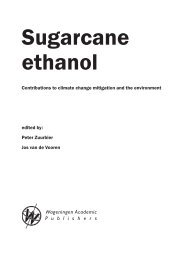Production and use of fuel ethanol in Brazil - BAFF
Production and use of fuel ethanol in Brazil - BAFF
Production and use of fuel ethanol in Brazil - BAFF
Create successful ePaper yourself
Turn your PDF publications into a flip-book with our unique Google optimized e-Paper software.
60<br />
As to <strong>in</strong>come distribution (engaged persons, 2002), 53 percent <strong>of</strong> the engaged<br />
<strong>in</strong>dividuals are paid the equivalent <strong>of</strong> up to two m<strong>in</strong>imum wages (half <strong>of</strong> whom<br />
earn<strong>in</strong>g less than one m<strong>in</strong>imum wage), <strong>and</strong> 1.3 percent more than twenty m<strong>in</strong>imum<br />
wages.<br />
C2.2.<br />
What is the share <strong>of</strong> the sugar-cane agribus<strong>in</strong>ess<br />
<strong>in</strong> the overall employment?<br />
The <strong>Brazil</strong>ian agribus<strong>in</strong>ess, taken as a whole, accounts for 20.6 percent <strong>of</strong> the<br />
country’s Gross Domestic Product (GDP) <strong>and</strong> 14 percent <strong>of</strong> all jobs. The sugar-cane<br />
<strong>in</strong>dustry employs 6 percent <strong>of</strong> all <strong>Brazil</strong>ian workers <strong>in</strong> the agribus<strong>in</strong>ess as accounts<br />
for 35 percent <strong>of</strong> São Paulo state’s GDP <strong>and</strong> rural jobs.<br />
<strong>Brazil</strong>’s sugar-cane grow<strong>in</strong>g bus<strong>in</strong>ess is responsible for around one million direct jobs<br />
(765,000 direct, formal jobs, RAIS 2002); around 520,000 people were employed<br />
<strong>in</strong> sugar-cane grow<strong>in</strong>g alone <strong>in</strong> 2002 (PNAD, 2003). In the State <strong>of</strong> São Paulo, there<br />
are around 400,000 direct jobs <strong>in</strong> the sugar-cane <strong>in</strong>dustry, <strong>and</strong> 95 percent <strong>of</strong> those<br />
workers are formally employed, thus hav<strong>in</strong>g all rights set forth <strong>in</strong> the labor legislation,<br />
<strong>and</strong> represent 40 percent <strong>of</strong> the state’s rural jobs. The absolute number <strong>of</strong> jobs<br />
<strong>in</strong> the <strong>in</strong>dustry decreased dur<strong>in</strong>g the 1990’s (<strong>in</strong>creased mechanical harvest<strong>in</strong>g <strong>and</strong><br />
improved management), <strong>and</strong> then rose aga<strong>in</strong> as a result <strong>of</strong> the <strong>in</strong>dustry’s expansion<br />
<strong>in</strong> the last few years.<br />
The seasonality rate <strong>of</strong> rural jobs has been decl<strong>in</strong><strong>in</strong>g as a function <strong>of</strong> agricultural<br />
mechanization <strong>and</strong> greater <strong>in</strong>vestments <strong>in</strong> pr<strong>of</strong>essional tra<strong>in</strong><strong>in</strong>g; it was estimated at<br />
2.2 <strong>in</strong> the late <strong>of</strong> the 1970’s, 1.8 <strong>in</strong> the late 1980’s, <strong>and</strong> then reached 1.3 at some<br />
plants <strong>in</strong> the mid 1990’s. It is a trend <strong>and</strong> is happen<strong>in</strong>g faster right now.<br />
It is very important to note that the formal employment rate <strong>in</strong> the <strong>in</strong>dustry is much<br />
above the national average; data from the PNAD <strong>and</strong> the 2003 RAIS (Annual Report<br />
on Social Matters) show that on the agricultural side <strong>of</strong> the bus<strong>in</strong>ess 72.9 percent<br />
<strong>of</strong> all jobs are formal <strong>in</strong> the country <strong>and</strong> 93.8 (2005) percent <strong>in</strong> the State <strong>of</strong> São<br />
Paulo (start<strong>in</strong>g from a rate <strong>of</strong> 80.4 percent <strong>in</strong> 1992). These figures po<strong>in</strong>t to a clear<br />
trend towards better work<strong>in</strong>g conditions, a lower seasonality, <strong>and</strong> improved labor<br />
quality.<br />
C. Sugar-cane <strong>and</strong> <strong>ethanol</strong> production: social impacts












